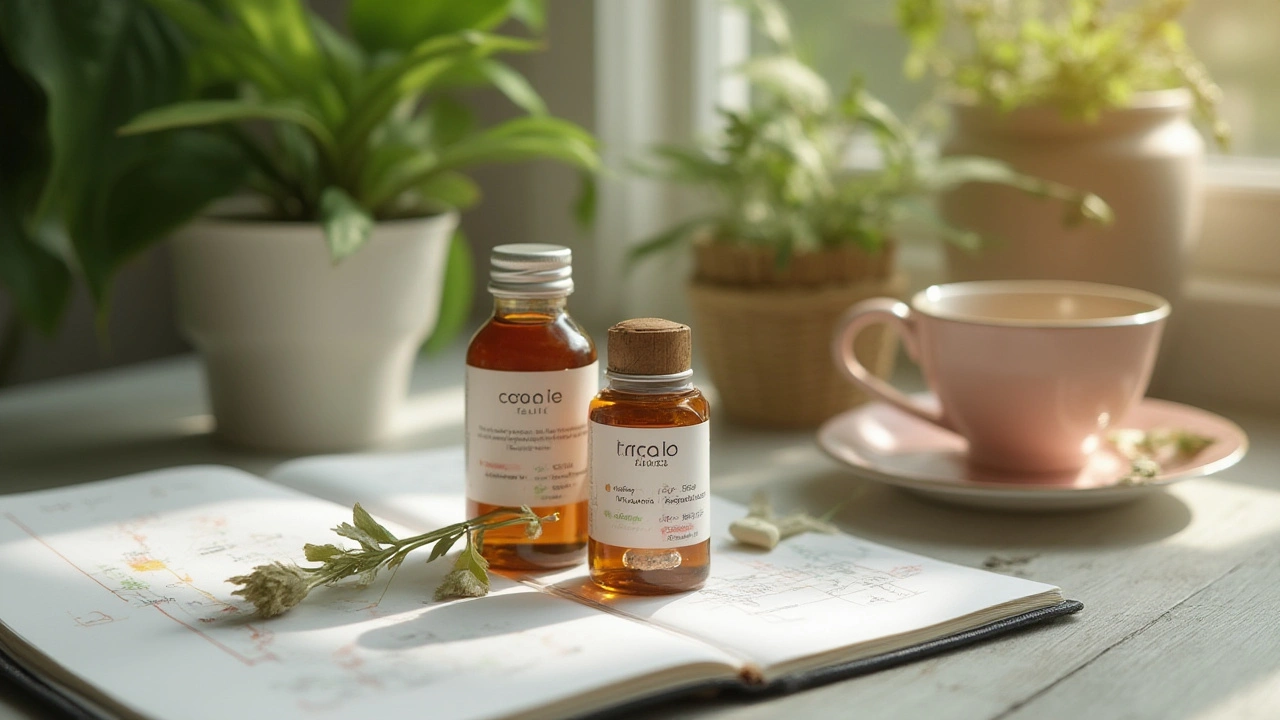Ever wondered why getting pregnant seems ridiculously easy for some people but feels like running a marathon in flip-flops for others? The truth is, fertility can be a real puzzle. While tons of folks are calling it quits with trips to the doctor and pricey medications, a growing number are eyeing non-prescription options: over-the-counter supplements, herbal blends, and even experimental therapies promising a friendlier path to conception. The demand has surged in 2025, with a recent IFHS survey showing a 47% increase in couples choosing non-prescription fertility aids before ever stepping foot in a clinic. But what’s legit and what’s hype?
The Science Behind OTC Fertility Aids
Let’s lay out the scene: you’re searching for a baby bump, but you want less hassle, fewer prescriptions, less eye-watering pharmacy prices. So you land on over-the-counter fertility boosters. These range from basic vitamins like folic acid to complex herbal cocktails promising to balance hormones, improve sperm motility, supercharge egg quality, and more. But does the science back up their bold claims?
First, not all supplements are created equal—manufacturer claims often outshine actual results. However, some have real research backing them up. For women, folic acid’s a classic—recommended by OB-GYNs everywhere and shown in study after study to support ovulation and healthy fetal development. Myo-inositol, once a little-known B-vitamin relative, has gained fame for its role in improving menstrual regularity and egg quality, especially in women with PCOS. A large 2024 trial out of Italy found women taking myo-inositol boosted ovulation rates by up to 22% compared to those on a placebo.
CoQ10’s another heavy hitter on the supplement scene. This antioxidant powerhouse plays a key role in mitochondrial health, which means better-quality eggs and sperm. Research from the University of Toronto (2025) showed CoQ10 supplementation resulted in a 15% increase in clinical pregnancy rates among couples struggling with unexplained infertility. For men, L-carnitine and zinc stand out. Both have been shown to significantly impact sperm count and motility. In one double-blind study, men on a combined regimen saw sperm counts jump by 50% after three months.
One thing every specialist will tell you: more isn’t always better. Super-dosing on fertility vitamins can actually backfire, especially fat-soluble options like vitamin E. And watch for supplements containing multiple ingredients in mysterious “proprietary blends”—you never really know what you’re getting. The smarter approach is picking a single-ingredient option where the science is clear.
What about herbal formulas? Vitex (chaste berry extract) sometimes earns rave reviews for restoring periods or combating luteal phase defect. Some small studies support its hormone-balancing effects, but evidence isn’t as robust as standard vitamins. Maca root, a Peruvian root touted for libido and energy, has become a favorite natural go-to; animal studies show some promise for sperm count, but quality human trials are thin.
And don’t ignore lifestyle—think diet, sleep, and stress. Supplements work best with a healthy foundation. Nutrient-dense foods (think leafy greens, nuts, salmon), good sleep hygiene, and managing anxiety make a bigger difference than most realize.
To keep your eye on what works, here’s a quick stat-packed comparison:
| Supplement/Therapy | Benefit | Study/Source | Effect Size |
|---|---|---|---|
| Folic Acid | Oocyte health, reduces neural tube defects | CDC Guidelines (2023) | ~20% improved ovulatory cycles |
| Myo-Inositol | Restores ovulation, esp. PCOS | Italian Clinical Trial (2024) | 22% increase in ovulation |
| CoQ10 | Improved egg & sperm quality | Toronto Study (2025) | 15% increase in pregnancy rates |
| L-carnitine | Sperm count/motility | Meta-analysis (2024) | Up to 50% improved sperm count |
| Vitex | Hormonal balance, cycle regulation | Small human studies | Mixed, anecdotal |
| Maca Root | Libido, energy, possible sperm boost | Animal studies | Unclear in humans |

Emerging Non-Prescription Therapies: What’s Gaining Ground?
2025’s seen a burst of new approaches that sit at the intersection of wellness and medical science. Some are getting real attention, both from health professionals and hopeful parents. Let’s break down a few that are popping up everywhere.
First up: Time-release antioxidant therapies. Unlike swallowing a handful of supplements in the morning, these patches or slow-dissolve tablets deliver a steady dose of antioxidants (think vitamin E, C, selenium) through the day. Some early research—mainly in Europe—suggests they’re better at maintaining optimal blood levels compared to standard pills, supporting gamete health more consistently.
Microbiome-balancing probiotics are another rising star, especially among women with recurrent miscarriages or unexplained infertility. Researchers at Harvard published a 2024 review pointing at growing evidence that vaginal and gut microbiome health directly influences fertility. Probiotic blends with specific Lactobacillus strains not only reduced vaginal infections but, in pilot trials, improved rates of implantation during natural and assisted cycles.
Acupuncture’s been around for centuries, but its blending with Western medicine is just hitting stride now. Several big studies—England’s NHS looked at over 1200 patients last year—showed measurable improvements in pregnancy rates (by about 10-12%) when acupuncture was combined with diet, exercise, and standard non-prescription supplements.
Then there’s the world of wearable ovulation trackers and fertility apps. The 2025 models are nothing like the basic strips and thermometers of five years ago. The best personal fertility monitors now use advanced biosensors—not just basal temp, but also hormone metabolites in skin sweat and saliva—to pinpoint optimal days to conceive. Some devices claim up to 95% accuracy (as per a recent German consumer trial). For women uneasy about side effects from fertility drugs, tech-enabled cycle tracking is a game changer.
Low-level laser therapy (LLLT) is one of the newer experiments, showing up in fertility clinics in Japan and South Korea. In a fascinating 2024 study, photobiomodulation treatments applied to the lower abdomen seemed to improve blood supply to the ovaries, potentially leading to higher egg quality and stronger ovulation. The science is still early, but the results have many hopeful couples asking about take-home versions.
DNA-based supplement customization—where your nutrients are tailored based on genetics—is starting to catch steam, too. Companies use mouth swabs to analyze genes related to folate metabolism, hormone receptors, or even oxidative stress tendencies. Then, they recommend custom supplement blends to cover gaps. There’s real promise, but these tests can be expensive and not every company’s offering is well regulated, so proceed with cautious optimism.
Of course, one major reason folks try non-prescription therapies is to avoid side effects or expense of traditional fertility meds. Popular prescription drugs like Clomid can have tough side effects, so people are always hunting for the best alternatives to Clomid that don’t need a doctor’s note or copay. It’s worth checking out real reviews before buying anything billed as a miracle cure online.

What Works, What Doesn’t, and Choosing Safely
You’re hunting for something real, not just empty promises. So how do you separate helpful from hype in the world of non-prescription fertility aids?
The best starting point is sticking to options with clear, searchable evidence: established vitamins, minerals, and antioxidants that have real clinical support. Anything with murky proprietary blends or ingredients you can’t pronounce is worth skipping. Look for brands that post independent lab test results—a “certificate of analysis” is your sign they’re not flying by night. Also, check dosage: too much zinc or vitamin A, for example, can actually impair fertility.
Remember, fertility isn’t a one-size-fits-all question. What boosts ovulation for a woman with PCOS might do nothing for someone with silent endometriosis or undiagnosed thyroid issues. Men and women both need to check other basics: up-to-date vaccines, alcohol and caffeine intake, exposure to heat or environmental toxins (like plastics or pesticides) that sabotage sperm and egg quality.
Mental health is just as real here as physical health. Try pairing any supplement or therapy with simple lifestyle upgrades—short walks after dinner, tech-free downtime, even a social media detox. Stress, insomnia, and doomscrolling can shorten cycles and lower sperm counts faster than a skipped dose.
Smart shoppers also read the fine print. Not all “fertility teas” and powders are free from contaminants or banned substances. The FDA sometimes flags supplements tainted with unlisted fertility drugs—just last year, they recalled three brands found containing prescription-only hormones. Always buy from trusted sources and review customer feedback online.
Lastly, don’t write off the value of patience and teamwork. Even the best non-prescription fertility aids take time—sometimes 3-6 months—before real changes show up in lab tests or on pregnancy sticks. Have your partner join you in healthier habits, and check in with a health professional (preferably a reproductive endocrinologist or at least your primary doc) before starting anything new, especially if you’re already managing a medical condition or on medication.
Ready to get strategic? The supplement game isn’t about who pops the most pills, but figuring out exactly what your body needs and what science really backs. And if you’re overwhelmed, there’s serious value in writing things down—track cycles, supplements, stress, sleep, and everything else. Most couples are surprised by subtle trends they only spot after a month or two of careful notes.
More than ever, 2025’s crowded market of non-prescription fertility aids requires making moves with a mix of optimism, research, and realistic expectations. The right path might take time, and it may not look like anyone else’s—but with a smart approach backed by the latest studies, you’ve got a better shot at making that dream a reality.



Mitali Haldankar
July 23, 2025 AT 22:27Honestly, the hype around every new pill feels like a meme 😂. While scientists chase antioxidants, most of us are just forgetting to sleep enough. A balanced diet and a good night’s rest beat a mysterious “proprietary blend” any day. And hey, if you’re scared of your wallet, stick to folic acid and a bit of CoQ10 – they’re cheap and legit. 🌱💊
snigdha rani
July 24, 2025 AT 01:13Wow, “proprietary blend” again? That phrase is basically a grammar red flag for “we have no idea what’s inside”. Simple rule: if you can’t pronounce the ingredient, skip it. It’s not rocket science – stick to single‑ingredient vitamins and you’ll avoid the nonsense. 🙄
Mike Privert
July 24, 2025 AT 04:00Great rundown of the options – it really helps to have a quick cheat sheet. For anyone just starting out, focusing on folic acid, myo‑inositol, and a modest CoQ10 dose is a solid foundation. Pair that with regular exercise and stress‑relief habits, and you’ll give your body a real chance. Keep tracking your progress and stay patient; the numbers usually improve after a few months.
Veronica Lucia
July 24, 2025 AT 06:47It’s fascinating how the line between wellness trends and evidence‑based medicine keeps shifting. While the science behind antioxidants is promising, we must remember that each body responds uniquely. Embracing both the data and the personal journey can create a more humane approach to fertility. In the end, the goal is not just a pregnancy test, but a healthier partnership.
Sriram Musk
July 24, 2025 AT 09:33From a safety perspective, dosage matters as much as the ingredient itself. For instance, CoQ10 is effective at 200 mg per day, but exceeding 600 mg offers no additional benefit and may increase oxidative stress. Likewise, zinc should stay below 40 mg daily to avoid impairing copper absorption. Always verify that the product provides a Certificate of Analysis, confirming purity and exact concentrations. This rigorous approach minimizes the risk of hidden contaminants while ensuring therapeutic efficacy.
allison hill
July 24, 2025 AT 12:20While the market touts natural solutions, one cannot ignore the subtle ways big pharma influences these ‘OTC’ claims. Recent FDA recalls have uncovered undeclared prescription‑grade hormones hidden in some fertility teas, suggesting a coordinated effort to bypass regulation. Consumers should treat every “clinically proven” label with suspicion unless the study is openly peer‑reviewed and the batch is independently tested. The paradox of increased access paired with covert manipulation is a hallmark of modern pharmaceutical stratagems.
Tushar Agarwal
July 24, 2025 AT 15:07Totally agree with the need for transparency – it’s scary when a supplement isn’t clear on its ingredients 😟. If you see a “proprietary blend”, it’s best to walk away or ask for exact component breakdown. Also, keep an eye on third‑party lab reports; they’re the real proof that you’re not getting a mystery cocktail. Stay safe and good luck! 😊
Richard Leonhardt
July 24, 2025 AT 17:53Your summary is spot on – truly definatly a great starting point for anyone feeling overwhelm. Folic acid and CoQ10 are both proven, and when you mix them with healthy lifestyle you boost your odds without breaking the bank. Remember, consistency is key; even small daily steps add up to big results. Keep the optimism high and the doubts low!
Shaun Brown
July 24, 2025 AT 20:40The current supplement landscape resembles a carnival of snake‑oil vendors more than a scientific marketplace, and the sheer volume of marketing hype obscures any genuine progress. First, the proliferation of time‑release antioxidant patches is marketed as a breakthrough, yet the pharmacokinetic data remain unpublished and the patents are held by companies with vested interests in proprietary formulations. Second, the probiotic claims rely heavily on extrapolations from gut microbiome research that, while exciting, have not been conclusively linked to human fertility outcomes in randomized trials. Third, the wearable ovulation trackers promise near‑perfect accuracy, but they ignore the inherent biological variability and often overpromise on predictive power, leading users to trust devices over their own physiological cues. Fourth, low‑level laser therapy is praised in a handful of small studies from Japan, but the sample sizes are insufficient to rule out placebo effects, and the commercial devices being sold for home use have not undergone rigorous safety testing. Fifth, DNA‑tailored supplement packages capitalize on the allure of personalized medicine, yet the underlying genetic associations are often based on limited genome‑wide association studies that lack replication. Moreover, the cost of these custom regimens is prohibitive, creating a socioeconomic divide where only affluent couples can afford the “future of fertility”. Sixth, the industry’s reliance on “proprietary blends” is a deliberate obfuscation tactic; without a clear ingredient list, neither clinicians nor consumers can assess potential interactions or toxicities, and this secrecy has already led to FDA recalls of products containing undeclared clomiphene. Seventh, the regulatory oversight is fragmented; while the FDA can act post‑hoc, the initial approval pathways for dietary supplements are lenient, allowing many products to reach shelves with minimal pre‑market evidence. Eighth, the relentless push for “natural” solutions often bypasses the necessary caution that medical professionals advocate, encouraging couples to delay professional evaluation until they have exhausted costly, unproven remedies. Ninth, the psychological toll of navigating this maze cannot be understated, as couples may experience increased anxiety and guilt when supplements fail to deliver expected results. Tenth, the involvement of influencers and celebrity endorsements further muddies the waters, providing anecdotal validation that overrides scientific skepticism. Finally, the only responsible path forward is a transparent, peer‑reviewed synthesis of data, coupled with clear labeling and independent testing, to separate legitimate therapeutic options from profit‑driven hype. Only through rigorous standards can we protect vulnerable patients from exploitation. Until then, hope must be guided by evidence, not marketing fluff.
Damon Dewey
July 24, 2025 AT 23:27Most of these “miracle” supplements are just a cash grab.
Dan Barreto da Silva
July 25, 2025 AT 02:13I once met a guy at a coffee shop who swore his sister’s brother used a DIY hormone cocktail and got a weird rash – I can’t help but wonder what they’re really putting in those bottles. Anyway, if you’re thinking about trying any of that, just remember the last time we trusted a stranger’s advice and ended up with a busted fridge. Stay safe!